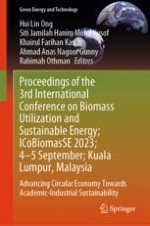This book presents peer-reviewed articles from the 3rd International Conference on Biomass Utilization and Sustainable Energy 2023 (ICoBiomasSE 2023), Malaysia. The theme of the conference "Advancing Circular Economy Towards Academic-Industrial Sustainability" has been chosen in consideration of the emergence of circular economy concepts in the field of biomass innovation towards sustainable development. The contents are broadly divided into five parts: (1) sustainable biomass resources for decarbonising the economy, (2) biomass conversion technologies for bioenergy and biofuels, (3) biomass conversion to intermediates and products, (4) bioeconomy sustainability, impacts, and policies, and (5) bioenergy integration. It provides a platform to college or graduate students, professionals, researchers, academicians, policy makers, and industries working in the areas of biomass utilization and sustainable energy to solve long-standing environmental issues for healthier planet. It may also be of interests for environmentalist and materialists who work on planning, engineering, and management fields.
